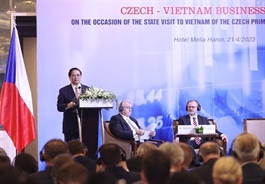Systemic weaknesses holding back impact of PSRD
Systemic weaknesses holding back impact of PSRD
The slow-paced implementation of a monetary policy is making it hard for the government to provide assistance for enterprises, cooperatives, and household businesses.

Prime Minister Pham Minh Chinh last week ordered the State Bank of Vietnam (SBV) to urgently work with the Ministry of Planning and Investment, the Ministry of Finance, and relevant agencies to boost the deployment of the government’s policy on offering 2 per cent lending rate from the state budget for enterprises, cooperatives, and household businesses via commercial banks.
Systemic weaknesses holding back impact of PSRD, illustration photo/ Le Toan
The units have been required by the PM so find solutions to deal with the remaining money of the initiative that cannot be disbursed, and then report to the government within this month.
According to the SBV, after two years of implementing this policy, the total disbursed sum has reached only $14.34 million out of $1.74 billion.
This package, which is part of the national Programme on Socioeconomic Recovery and Development (PSRD) also under slow implementation, is now reported to be almost impossible to be carried out because of complex regulations.
For example, the National Assembly’s January 2022 resolution on specifying some fiscal and monetary policies to support the PSRD regulated that enterprises, cooperatives, and household businesses must demonstrate their “recovery ability” if they want to benefit from the 2 per cent lending rate.
“Under this, having ‘recovery ability’ is a very difficult condition for those wishing to benefit from the lending rate incentive. Both commercial banks and enterprises said that it would be hard to specify what the recovery ability is. This condition is a tough nut to crack,” said SBV Deputy Governor Dao Minh Tu.
Deputy Prime Minister Le Minh Khai said that implementation would mean the use of the state budget, so strict procedures must be obeyed. However, he also admitted that the condition of “recovery ability” is unclear and difficult to assess, making it hard to implement.
He recommended that the SBV continue directing commercial banks to make possible solutions to disburse the policy in order to support people and businesses who are now facing massive difficulties. “If the money must be transferred to other policies, it is necessary to clarify what the policies are and how feasible they are,” Khai said.
In February, the government also required the SBV to soon submit to it for promulgation of a new decree on amending and supplementing Decree No.31/2022/ND-CP dated May 2022 on the 2 per cent lending rate support.
A month later, the SBV issued a document requiring its branches nationwide and credit institutions to boost the implementation of the lending rate assistance.
In January 2022, a plan was agreed to use a maximum sum of $1.74 billion for the rate assistance package. However, the SBV reported that by late last year, disbursement from this initiative remained at a very slow pace, standing at only over $5.83 million, or just over 0.3 per cent of the total.
Carolyn Turk, country director for the World Bank in Vietnam, said turbulence in Vietnam’s monetary and financial markets in 2022 has not helped.
“While authorities acted promptly to restore market confidence, many systemic weaknesses in the banking and financial markets were revealed – and they could potentially affect Vietnam’s macroeconomic stability. Addressing these weaknesses with decisive and coordinated reforms will not only ensure stability but also efficiency and long-term growth of the economy,” Turk said.
According to the World Bank, in order to effectively support enterprises out of difficulties, it is recommended that the monetary policy remain prudent.
The bank stated that fiscal balances will continue to be determined by the higher-than-planned revenue collection and implementation challenges affecting the capital budget. The authorities plan to roll out the investment component of the PSRD amounting to about 1.6 per cent of GDP with projects that were prepared during 2022.
Given the persistent under-execution of capital spending in the past, this initiative is expected to be partially rolled out imminently.
“The SBV will calibrate short-term policy responses in coordination with fiscal authorities. Its medium-term mandate of exchange rate management and inflation risk containment is unchanged,” the World Bank said.






















